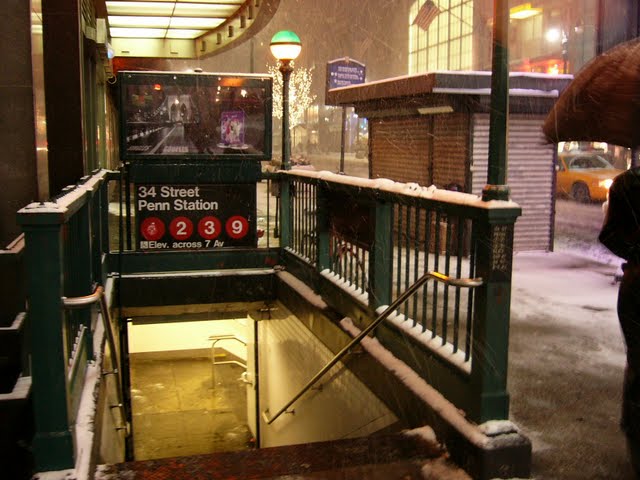
Street artists are increasingly turning to non-destructive, paint-free forms of graffiti to make a point without permanently defacing property. Their urban pranks and social protests engage mobile gadgets, open-source software, and online social networking. They blend aesthetics from the hip-hop, punk, and do-it-yourself arts and crafts movements to convey messages from the silly to the politically provocative. Free speech, environmentalism, and anti-war messages are common themes.
Artists with the Graffiti Research Lab play laser tag by scribbling with light beams onto buildings. Targets have included the Roman Coliseum (shown here) and Brooklyn Bridge. For the projects, they use a camera, a laptop with open-source software, a projector, and a green laser. Equipment for the mobile, interactive laser shows can be mounted in a camper or car, or on a bicycle.
The summer tour of Graffiti Research Lab, an offshoot of the nonprofit Eyebeam arts center, is working on a new laser tag technology dubbed Green Lantern that can project images on the scale of Batman's bat signal.

Paul Notzold creates digital performance art by projecting live text messages onto buildings. The public can participate in the "projection bombing" by calling the number of a cell phone he pairs with a projector and proprietary software on a Mac. This example from April appeared on the University of Texas campus in Austin.
"The proliferation of media devices has started to level the playing field for a motivated individual to go out in public space and cause a stir unsponsored," Notzold said.
Similarly, during the 2004 World Summit on the Information Society, Swiss artist Johannes Gees ran the HELLOWORLD Project. It laser-beamed 38,000 SMS messages onto the United Nations headquarters and on buildings in Brazil, India, and Switzerland. In Rio de Janeiro, the 200-foot letters could be seen from more than a mile away.

Artist and designer Notzold partnered with Adam Chapman on this "Drip TXT" project in Brooklyn in the spring of 2007. It spells out text messages in the graffiti writing style of the street artist named Jesus Saves.
Other efforts bridging outsider street art with the Internet have included Flickr pools of graffiti photos and Grafedia.com. The Yellow Arrow project was developed to link real-world locations to stories online. Through the Wiffiti service, participating cafes enable "Wi-Fi graffiti" by projecting text messages onto their walls.

"Street art is flourishing in many cities around the world thanks to the Internet," said Lee. "This trend is part of the same mentality behind open source and Creative Commons, which enable everyone to share, collaborate, and transform creative ideas to touch and inspire others."
On the right is Steve Lambert's "Light Criticism." He used a laser cutter to spell out a message in black foam core that obscured a New York City video billboard some two years ago. It was a joint effort with his Anti-Advertising Agency and Graffiti Research Lab.
"Advertising is the vandalism of the Fortune 500," Lambert wrote on his Web site.

Renting the LED screens costs several hundred thousand dollars each month, which Eppink finds unfair for shutting out the majority of artists. He's planning more installations this summer.
Expanding upon the Pixelator, an artist adopting the name Poster Child in June mounted a chipboard construction spelling the word "hold" over a video billboard, creating the stained glass effect shown on the left.
On a radical, ad-busting mission for three decades, San Francisco's Billboard Liberation Front this year used street displays to protest AT&T's cooperation with government wiretapping, as well as Google's practices in China.
Some people use glow sticks, torches, and fireworks to draw air graffiti, which only becomes visible in a time-lapse photograph. Their icons and messages tend to be more whimsical than political. Gabe Tse and Nathan Crum made these Pac-Man characters in Tucson, Ariz., earlier this year.
Video game characters are a common motif in renegade art projects, such as mosaics installed around the world by the artist known as Space Invader.
Credit: Gabe Tse and Nathan Crum
Joshua Kinberg equipped a bicycle with a custom printer in advance of the 2004 Republican National Convention in Manhattan. As he rode, the contraption would spell out dot-matrix biodegradable chalk messages, texted to him via Bluetooth cell phone, on the sidewalk. Here, "I love New York" is being spelled.
The Institute for Applied Autonomy's graffiti-writing robot and the Hektor spray-painting gadget inspired Kinberg. He planned to upload images of his interactive "Bikes Against Bush" project to a GPS map.
However, two days before the convention, police arrested Kinberg during an interview with MSNBC's Hardball TV show, confiscated his equipment, and sent him to jail for a day. He didn't get the bicycle back. The New York Times later reported that New York police illegally spied on him.
Kinberg was unable to complete the project, but its reach expanded virally through the Internet. He has since been working on video syndication technologies.











No comments:
Post a Comment